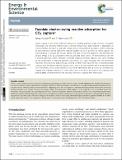Faradaic electro-swing reactive adsorption for CO2 capture
Author(s)
Voskian, Sahag; Hatton, Trevor Alan
DownloadPublished version (6.998Mb)
Publisher with Creative Commons License
Publisher with Creative Commons License
Creative Commons Attribution
Terms of use
Metadata
Show full item recordAbstract
Carbon capture is one of the foremost methods for curtailing greenhouse gas emissions. Incumbent technologies are inherently inefficient due to thermal energy losses, large footprint, or degradation of sorbent material. We report a solid-state faradaic electro-swing reactive adsorption system comprising an electrochemical cell that exploits the reductive addition of CO2 to quinones for carbon capture. The reported device is compact and flexible, obviates the need for ancillary equipment, and eliminates the parasitic energy losses by using electrochemically activated redox carriers. An electrochemical cell with a polyanthraquinone–carbon nanotube composite negative electrode captures CO2 upon charging via the carboxylation of reduced quinones, and releases CO2 upon discharge. The cell architecture maximizes the surface area exposed to gas, allowing for ease of stacking of the cells in a parallel passage contactor bed. We demonstrate the capture of CO2 both in a sealed chamber and in an adsorption bed from inlet streams of CO2 concentrations as low as 0.6% (6000 ppm) and up to 10%, at a constant CO2 capacity with a faradaic efficiency of >90%, and a work of 40–90 kJ per mole of CO2 captured, with great durability of electrochemical cells showing <30% loss of capacity after 7000 cylces.
Date issued
2019-10Department
Massachusetts Institute of Technology. Department of Chemical EngineeringJournal
Energy and Environmental Science
Publisher
Royal Society of Chemistry (RSC)
Citation
Voskian, Sahag and T. Alan Hatton. "Faradaic electro-swing reactive adsorption for CO2 capture." Energy and Environmental Science 12 (2019): 3530-47 ©2019 Author(s)
Version: Final published version
ISSN
1754-5692
1754-5706